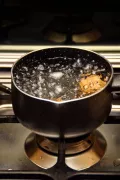Cooking methods can be confusing, especially when it comes to poaching and boiling. While these techniques may seem similar, there are key differences that can impact the outcome of your dish. In this article, we’ll explore the differences between poaching and boiling, and provide guidance on which method to use for optimal results.
What is Poaching?
Poaching is a gentle cooking technique that involves cooking food in liquid at a low temperature. The temperature used for poaching typically ranges from 160°F to 180°F, and the liquid used is usually water or a broth.
Poaching is an ideal method for delicate foods like fish, chicken, and eggs. When poaching, the food is immersed in the liquid and cooked until it is just cooked through. This method helps to preserve the natural flavors and nutrients of the food, and results in a moist and tender texture.
What is Boiling?
Boiling is a rapid cooking method that involves heating a liquid to its boiling point, typically 212°F. This method is commonly used for cooking vegetables, pasta, and grains. When boiling, the food is submerged in the liquid and cooked until it reaches the desired level of tenderness.
Boiling is a quick and easy method of cooking that allows you to infuse flavor into the liquid. However, overcooking can result in loss of nutrients and a mushy texture.
Key Differences Between Poaching and Boiling
The key differences between poaching and boiling are the temperature and liquid used. Poaching uses a lower temperature, while boiling uses a high temperature. Poaching uses a liquid that is gentler in flavor, while boiling can use a more heavily flavored liquid.
The type of food being cooked also impacts the choice of method. Delicate foods like fish and eggs are best poached, while heartier foods like vegetables and pasta are better boiled. Additionally, poaching is ideal for preserving the natural flavors and nutrients of the food, while boiling is better for infusing flavor into the food.
When to Use Poaching
Poaching is an ideal method for cooking delicate foods that need gentle heat to cook properly. For example, poached eggs are a popular breakfast dish that are simple to make and require minimal effort. Poaching is also great for cooking fish, as it helps to retain the natural flavors and moisture of the fish.
Poaching is also a good method for cooking chicken or pork, especially when used for dishes like stews or soups. The low temperature of poaching ensures that the meat remains moist and tender, making it perfect for soups and stews.
When to Use Boiling
Boiling is a great method for cooking heartier foods like vegetables, pasta, and grains. Boiling is a quick and easy method that results in tender and flavorful dishes.
Vegetables like broccoli and cauliflower are ideal for boiling, as it helps to soften them without losing their flavor. Boiling is also great for cooking grains like rice or quinoa, as it helps to cook them evenly and infuses them with flavor.
Tips for Perfectly Poaching or Boiling
While poaching and boiling are relatively simple cooking techniques, there are a few tips you can follow to ensure your dishes come out perfectly:
- Use a thermometer: To ensure your liquid is at the correct temperature for poaching, use a thermometer to check the temperature of the liquid. This will help you avoid overcooking or undercooking your food.
- Be patient: Poaching and boiling are gentle cooking methods that require patience. Avoid the temptation to increase the heat or cook your food for too long, as this can result in tough and dry dishes.
- Add flavor: While the liquid used for poaching is typically water or a broth, you can add herbs, spices, or other flavorings to infuse more flavor into your dish. When boiling vegetables or pasta, consider adding salt or other seasonings to enhance the flavor.
- Use a timer: To avoid overcooking your food, set a timer for the recommended cooking time. This will help you ensure that your food is cooked through but not overdone.
- Use a slotted spoon: When removing your food from the liquid, use a slotted spoon to avoid breaking or damaging it. This is especially important for delicate foods like eggs and fish.
Recipes for Poaching and Boiling
Looking for some inspiration for your next poaching or boiling adventure? Here are a few simple and delicious recipes to get you started:
Poached Eggs:
- Fill a large pot with water and bring to a gentle simmer.
- Crack your eggs into individual ramekins or small bowls.
- Use a spoon to create a gentle whirlpool in the water.
- Gently pour the eggs into the whirlpool and cook for 3-4 minutes.
- Remove the eggs with a slotted spoon and serve on top of toast or with a side of vegetables.
Boiled Broccoli:
- Bring a large pot of salted water to a boil.
- Add the broccoli and cook for 3-5 minutes, or until tender.
- Drain the broccoli and toss with butter, lemon juice, or your favorite seasonings.
Poached Chicken:
- Place boneless, skinless chicken breasts in a large pot and cover with water or broth.
- Bring to a simmer and cook for 10-15 minutes, or until cooked through.
- Remove the chicken from the liquid and shred or slice as desired.
Boiled Pasta:
- Bring a large pot of salted water to a boil.
- Add your favorite pasta and cook for 8-10 minutes, or until al dente.
- Drain the pasta and toss with your favorite sauce or toppings.
Which Method to Use
When it comes to poaching vs. boiling, the choice of method will depend on the type of food being cooked and the desired outcome. If you're looking to cook delicate foods like fish or eggs, poaching is the way to go. However, if you're cooking heartier foods like vegetables or pasta, boiling is a better option.
Ultimately, the key to successful poaching or boiling is to keep a close eye on your food and avoid overcooking. By following the tips and recipes provided in this article, you'll be able to create delicious and healthy dishes that are sure to impress.
Conclusion
Poaching and boiling are two popular cooking methods that have different applications. When deciding which method to use, it’s important to consider the type of food being cooked and the desired outcome. Poaching is a gentle and slow method that is best for delicate foods like fish and eggs, while boiling is better for heartier foods like vegetables and pasta.
No matter which method you choose, it's important to keep a close eye on your food and avoid overcooking. Overcooking can lead to tough and flavorless dishes, so be sure to remove your food from the heat as soon as it's cooked through.
In conclusion, poaching and boiling are two different cooking techniques that can help you achieve delicious and flavorful dishes. By understanding the key differences between the two methods, you can choose the best one for your dish and create meals that are both healthy and delicious.










